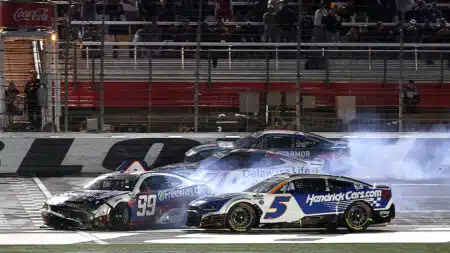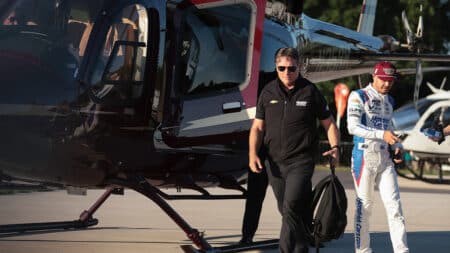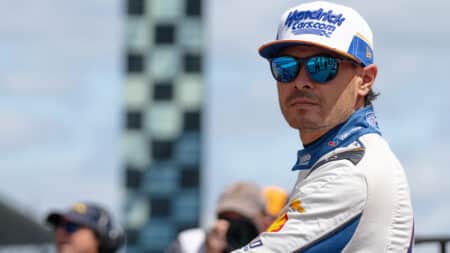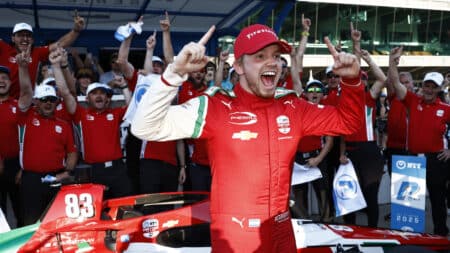
'Double isn't worth it', says Larson after 2025 attempt ends in disaster
Two crashes left Kyle Larson's hopes of completing the Indy 500 and Coca Cola 600 double in tatters — but did he even stand a chance in the first place?
After five or six years in the wilderness, Graham Rahal has come on strong this summer and with only two races to go he’s suddenly threatening to steal the IndyCar title from Indy 500 winner Juan Pablo Montoya’s grasp.
A pair of wins in the California 500 at the end of June and Mid-Ohio two weeks ago have pushed Rahal to within nine points of Montoya, with Scott Dixon also lurking menacingly in the mix just 25 points behind Rahal. But Rahal’s Mid-Ohio win has put him on the brink of pulling off one of motor racing’s biggest upsets of the year.

Since becoming Indycar racing’s youngest winner at 19 with Newman/Haas in 2009, young Rahal’s career has floundered. First, Newman/Haas went out of business, followed by a few frustratingly unsuccessful years with Chip Ganassi’s new B-team before moving to his father Bobby’s team two years ago in an attempt to kick-start his career. The first two seasons didn’t go well, but after Bobby made some major changes to his team last winter Graham has been the revelation of the 2015 IndyCar season.
“With all the doubting Thomases, it’s nice to prove that he can drive,” Bobby remarks. “Honda’s been working hard and the engineering in the team is really good. There’s a very positive atmosphere in the team. All that is making a difference.”
For his part, Graham could not have been more delighted to win at Mid-Ohio. “As you know, Mid-Ohio is our home track and it was great for me to see the fans literally climbing the fences, screaming and waving Ohio State Buckeye flags,” Graham grins. “That sense of pride in winning a race for them as well as me probably will never happen again in my career. I really felt that the crowd was rallying completely around me. It was just amazing.
“I said to a lot of people that we had to win that race. There was no other way around it. We had to win to have a chance to contend for the championship. Partway through the race I knew I was quicker than the line of cars I was behind. But I was stuck in traffic and couldn’t go anywhere or do anything. It was frustrating, but we made a strategy call that worked out unbelievably well.

“It was actually my call. [Carlos] Muñoz and somebody else in front of him were holding us up pretty bad and I decided it was best to get out of traffic. I said I was coming in and they asked why. They said I had enough to save fuel to the end. But I wanted to get out of traffic and see what we could do in clean air.
“I thought that Montoya and those guys behind me would all come in too but they didn’t. Possibly that was the Honda showing some fuel mileage advantage over the Chevy. We knew it would be hard for them to make to the end but it wasn’t for the Honda. Anyway, it couldn’t have worked out any better. I ended up at the front in clean air without any fuel mileage worries and they ended up stuck in traffic.”
After winning the race Graham stopped on his cool-down lap at the esses, where a big portion of the crowd always gathers at Mid-Ohio, and gave them a couple of celebratory doughnuts. He was told not to do any doughnuts in order to minimise any damage to his engine, but didn’t hear the command.
“I feel bad about that now because apparently they told me on the radio not to do any burnouts,” Graham says. “But I never heard them. With about 15 laps to go I told them to stop talking to me simply because the radio was crackling so badly. I couldn’t understand what they were trying to say. Somehow, we were losing battery power for the radio. So I never heard them say don’t do any burnouts, but it was worth it for the fans.”

At the end of last year Bobby made some major changes to the key personnel in his IndyCar team. “Last year, the chemistry in the engineering office just was not there,” he observes. “The chemistry between the driver and the lead engineer was not positive. There were some good races. When the car was good we were quick most of the time, but we also had some mechanical issues.
“I felt that in the right car Graham would do the job. Like with any driver, you have to have all the ingredients, and it was clear things weren’t gelling as I had hoped. So I had to make some changes.”
Rahal promoted veteran engineer and former driver Eddie Jones to be his son’s race engineer and hired Mike Talbott and Martin Pare to strengthen his team’s vehicle dynamics and R&D departments.
“Eddie Jones has been with the team for a number of years and we decided to make Eddie the lead engineer,” Bobby relates. “He’s a little bit old school, but that doesn’t underestimate or understate his capabilities. He’s got a lot of experience in Indycar racing with good teams and drivers so we made Eddie the primary engineer for Graham.

“At the same time I had reached out to Mike Talbott who I had known since he was at Newman/Haas/Lanigan, where he was Justin Wilson’s engineer the year Graham was there. I saw that Mike was a very capable guy and we were able to get him. Mike is more involved on the simulation side and crunching those numbers more so than actually at the track as a race engineer. With Mike coming on board we’ve tried to broaden the capabilities of the engineering group.
“One area that’s of key importance is the whole vehicle dynamic aspect from the dampers to third spring – you name it. We were really fortunate to get Martin Pare who had been Graham’s engineer at Newman/Haas/Lanigan, and at Ganassi. When Graham came to us I tried to hire Martin but he was returning to Canada because his wife had a very good job in Toronto. So he went to work for Multimatic, but we kept in touch in recent years and I just reached out to him.
From the archive: Bobby wins the big one for Jim Trueman
“I invited Martin to join our vehicle dynamics group with Cole Selva and a couple of other guys. Martin took over the leadership of that group and he did a really deep study on damping.
“Eddie was the constant. He had been with the team since we re-organized in 2012 so we elevated Eddie and brought in Mark and Martin to strengthen our whole engineering effort and it’s been fantastic. There’s a very collegial atmosphere in the engineering department. It’s a very positive environment and the value each of those guys have produced for us has been what I hoped for.

Rahal with Martin Pare, 2011
“We also hired Stuart Kenworthy, a damper guy. Stuart’s got a lot of experience and he’s working with Martin and Cole. I think we’ve made a lot of progress on the damping side. I think certainly that’s a credit to those three guys. Cole has been with us a long time and has done a lot of work on the R&D side and that’s a very happy group.
“Also, Derek Davidson has come to us from Dreyer and Reinbold. We elevated him from a chief mechanic to crew chief and he’s done a great job. So we took some of the people we had and put them in other positions and said, ‘Here’s your chance.’ Derek has done a great job.
“At the same time Ricardo Nault has been with us since the early ‘90s. He moved over to Indy from Columbus last year and I decided it was Ricardo’s team to run. I decided I was going to get out of the way and let those guys do their jobs and the proof is in the pudding. Ricardo has done a fantastic job running the team. He’s a racer’s racer. He’s very competitive and he’s developed a very good atmosphere among the race team and crew.
“The biggest byproduct of all these changes is that the atmosphere in the organization is just 180 degrees from where it had been. I let Ricardo and the guys do their jobs. My job is to find the funding, make the big picture decisions and give those guys the tools they need to do their jobs. That’s my job.

“For me, it was kind of withdrawing on a day-to-day basis. There’s much less communication between me and Ricardo. We have weekly conference calls to bring me up to date on what’s going on but I let them do their jobs.
“That included taking myself off the timing stand. I loved being the radio with Graham but it was clear there were times when emotions ran high. I said to Graham last winter that we need to get the emotion out of it. I said we need to be less passionate in the car and on the pit stand and one way to do that was for me to walk away and to observe from elsewhere. I still help out by spotting but I think not being on the timing stand has proven to be a positive change.
“We decided we had to change the atmosphere and I think we had to make all those changes to try to get to that goal. I think those changes have been good for the team and for Graham.”
Graham agrees wholeheartedly with his father. “It’s been great,” Graham grins. “Eddie’s done an excellent job. He’s been very involved and really helped get the team on track. Martin is a guy I’ve always been very fond of. I worked with him at Newman/Haas and Ganassi and I had nothing but respect for the guy. He’s an incredible engineer. He’s very well thought out with a calm demeanour and Mike Talbott is the same.

“So when we put these three guys together it’s been like magic. They clicked from the very beginning and everything worked. There’s never any second-guessing. There’s always teamwork to a tee, which is something we didn’t have last year, and we made the car significantly better handling-wise. Did we improve our shocks a ton from last year? No, but it’s the way of working that’s really helped us and put us in a much better place.”
Ricardo Nault is Rahal/Letterman/Lanigan’s IndyCar team manager. Nault has been with Rahal for more than twenty years since the end of 1993. “Part of Eddie Jones’s drive has been to make a happy environment so Graham can enjoy racing again and he’s done that,” Nault says. “Eddie and Graham work well together and Eddie is a really stable guy. He’s easy to get along with and he understands when the car’s not good and how to make it better.
“The other thing is Eddie will take responsibility for a bad car. When Graham says it’s not working well Eddie will listen to him and take a look at the set-up. They do a really good job of talking through it together.”
Of course, it’s doubly impressive that Rahal is achieving so much this year as a single-car team against the four-car operations from Penske, Ganassi and Andretti. “I think, being a single-car team, there’s a focus and simplicity to that that’s generating real results,” Bobby comments. “From a team standpoint, the more cars you have, the better it’s going to be. And from a performance standpoint I think there’s probably times when it would be great to have a second car to try things and get some feedback as we did at Indy when we ran Oriol [Servià] in a second car.

Servia (32) and Rahal (15) at Indy
“But the focus on a single car can be powerful if you can figure out the basic setups that the driver likes. I think it’s not a negative being a one-car team but you have to have a very hard working, very committed group of people to get those results.”
Again, Graham agrees with his father and boss. “I think my dad is right in the sense that there are times when I could use somebody else with some different data to help give us some insight. But, having said that, we’ve had fewer distractions so we’ve been able to focus solely on getting our car to the top and focusing on what we need to be the best.
“Luckily, it’s all worked out, but trust me, there have been times when we struggled because we didn’t have any data from another car. But at the end of the day things have seemed to work out quite well.”
Adds team manager Nault: “Everybody has done a really good job of not looking for the excuses but looking at ourselves and how we can be the best team we can be. There’s a lot of things going against us as a one-car team, but there’s a lot going right for us if we can work well together from Eddie down to our apprentice mechanics. It means so much for everyone to push in the same direction and it’s important for Graham to know we’re all behind him.

“We try to do everything we can and for the most part there’s been no grumbling. We’ve gone back and redone things when necessary. Everyone takes pride in their work. It’s all about the little details. Put them all together and you have something.”
In part two next week, Bobby, Graham and Nault discuss Honda’s 2015 ‘aero kit’ and engine program, the eternal pursuit for sponsorship and their approach to the championship battle with Juan Pablo Montoya and Scott Dixon in the year’s final two IndyCar races.
Part two of this feature will be online next Friday, August 21

Two crashes left Kyle Larson's hopes of completing the Indy 500 and Coca Cola 600 double in tatters — but did he even stand a chance in the first place?

The crunch point of Kyle Larson's Indy 500 and Coca Cola 600 double bid will come as he races from Indianapolis to Charlotte in a complex procedure involving cars, helicopters and planes. Ryan Glenn will be co-ordinating it... by text message

Kyle Larson will once again attempt the double this weekend. He explains his plans to complete the Indy 500 and NASCAR's Coca-Cola 600 in one day and overcome the "PTSD" of last year's bid

Robert Shwartzman and Prema stunned the field by claiming pole position for the 2025 Indianapolis 500 in his first-ever oval race. Here's a look at how they pulled it off